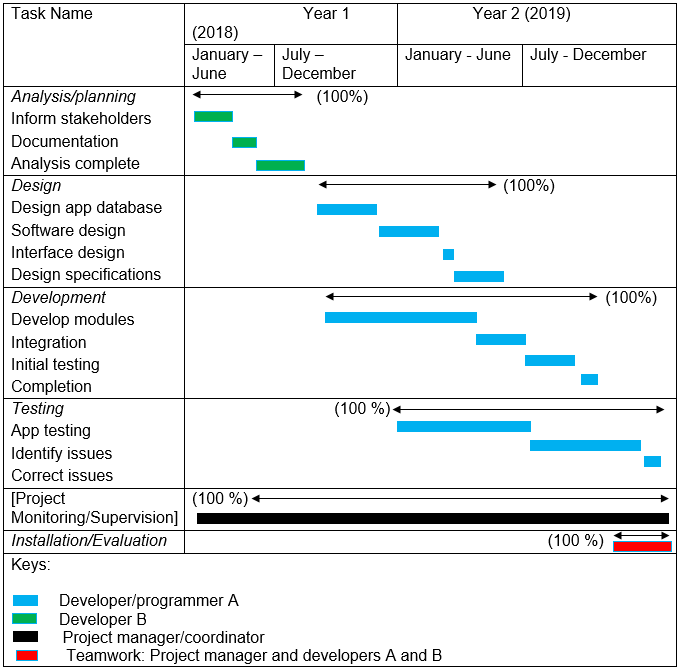Introduction
One of Zayed University’s objectives is to continue meeting the diverse needs of its students to achieve their potential. The introduction of advanced applications and systems can ensure that this goal is realized. The current proposal seeks to design and introduce a superior app that can support every financial aid student. The move will minimize most of the obstacles and challenges associated with the existing manual financial allocation system. This second part of the project gives a detailed work breakdown structure, a costs/budget proposal, and a time management plan.
Detailed WBS
The work breakdown structure presented below will be used to guide the performance and goals of the project team. The members of the team will work together to solve emerging problems, develop the app uses the best programming tools and procedures, and launch it within the outlined time (see Figure 1). The inclusion and involvement of different stakeholders will make the process successful. The most important thing, therefore, is for every participant and stakeholder in the university to be supportive throughout the app development period.

Project Team
The nature of the suggested app requires that a powerful team is formed to manage the entire development process. Three individuals will form this project team. The first member will be the project manager. He or she will monitor the progress of the designing, planning, programming, and implementation processes. The manager will also coordinate various activities, ensure that the right resources are available to the team, and liaise with the institution’s top management to address emerging concerns. The manager will also coordinate efforts and initiatives to ensure that the app is developed and launched successfully.
The second and third members will include programmers or app developers. These individuals will be tasked with every technical aspect of the application development process. The individuals will share specific roles and identify their respective objectives depending on the targeted outcomes. The team members will be required to sensitize different stakeholders about the benefits of the app. They will also educate different students and empower them to use the new app efficiently. The ultimate goal is to make sure that the app is designed and implemented successfully within the stipulated period.
Time Management Plan: Critical Path Using CPM
The chart below shows how the proposed app development process will be executed. The estimated time for the project is two years. As described earlier, the app will be developed and managed by three individuals. The project manager’s role is to oversee various operations to ensure that every activity is completed proficiently. The chart also goes further to embrace the concept of the critical path using CPM. This is the case because the roles and duties of every person are described in the time plan. Additionally, the arrangement shows the time that will be taken by every team member throughout the development and implementation phases.

During the analysis and planning phases, developer B will communicate and liaise with different parties within six months. The approach will ensure that every activity is planned and executed efficiently. The strategy will be used to acquire the right resources during the period. The level of coordination and support will empower different members to pursue their roles efficiently and deliver meaningful results.
The concept of resource utilization is also captured in this time management plan. From the presented plan, it is evident that programmers A and B are expected to undertake most of the roles and activities. During the design and development phases, developer A will be required to complete every activity. The deployment phase will be supported by the project team.
The use of this approach will make it easier for the team to manage time properly, acquire adequate resources, sensitize different stakeholders, and address emerging issues (see Figure 2). The ultimate goal is to ensure that the FASA app is implemented successfully to meet the diverse needs of more students at Zayed University. It should also be important to note that some changes can be made to the above time management plan depending on any emerging issues, concerns, proposals, or needs.
Estimated Costs and Budget
The proposed project should be sustainable if it is to deliver meaningful results and support the needs of many students in the targeted university. That being the case, there is a need to coordinate, shrink, and combine different activities to reduce operational costs throughout the app development process. The programmers will be required to minimize costs, utilize resources efficiently, and use some of the existing assets and systems in the institution.
Figure 3: Estimated budget.
The above table reveals that the estimated cost or expenditure for the proposed project is $5,700 (see Figure 3). The developers will also be keen to ensure that the estimated cost is reduced significantly to make the app sustainable. Additional expenses might also be incurred to guide and train different stakeholders. This approach will be considered in an attempt to support the needs of more students in the university and make it easier for them to pursue their academic goals.
Conclusion
The above time management plan, work breakdown structure, and estimate cost (and budget) are expected to sustain the proposed app development project. The involved development team will be required to focus on each role diligently. The time management plan is also based on the concept of resource utilization. This means that every role or activity will be completed efficiently and on time. The institution should, therefore, offer adequate support throughout the process to ensure that the app is developed successfully. Consequently, the financial needs of many students in the university will be met, thereby empowering them to pursue their educational and professional objectives.